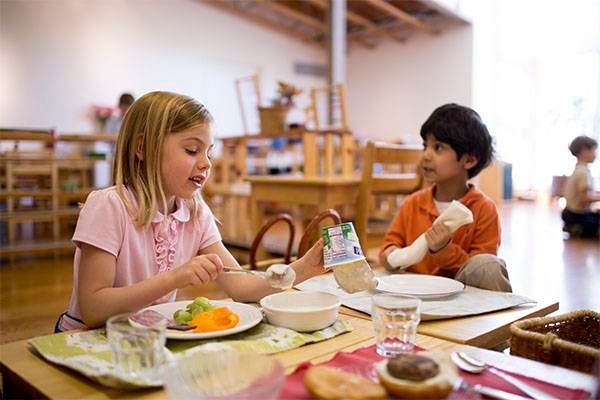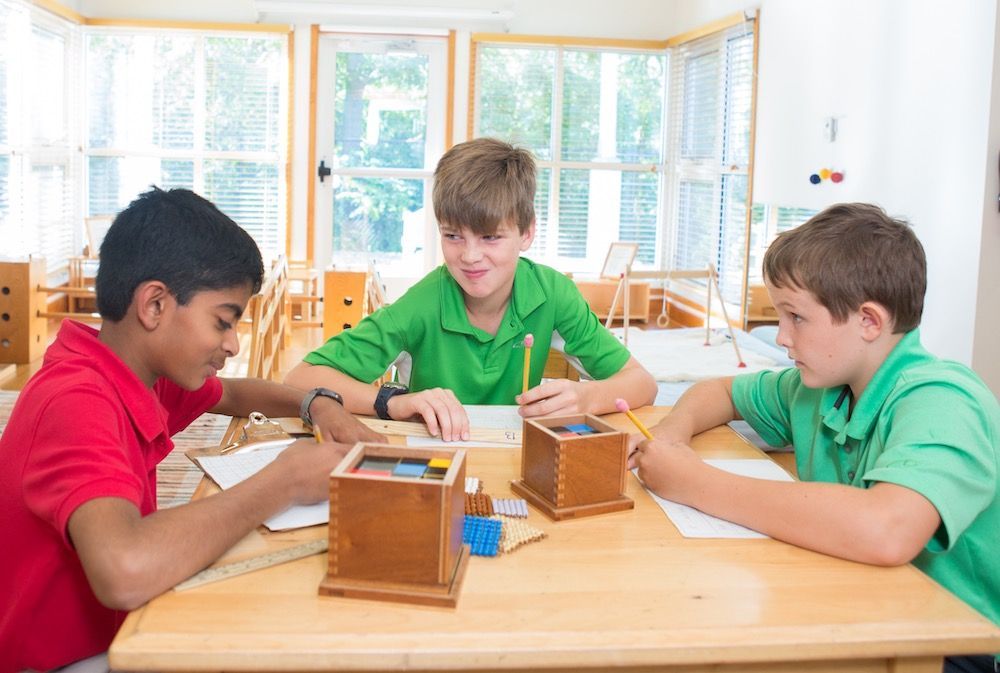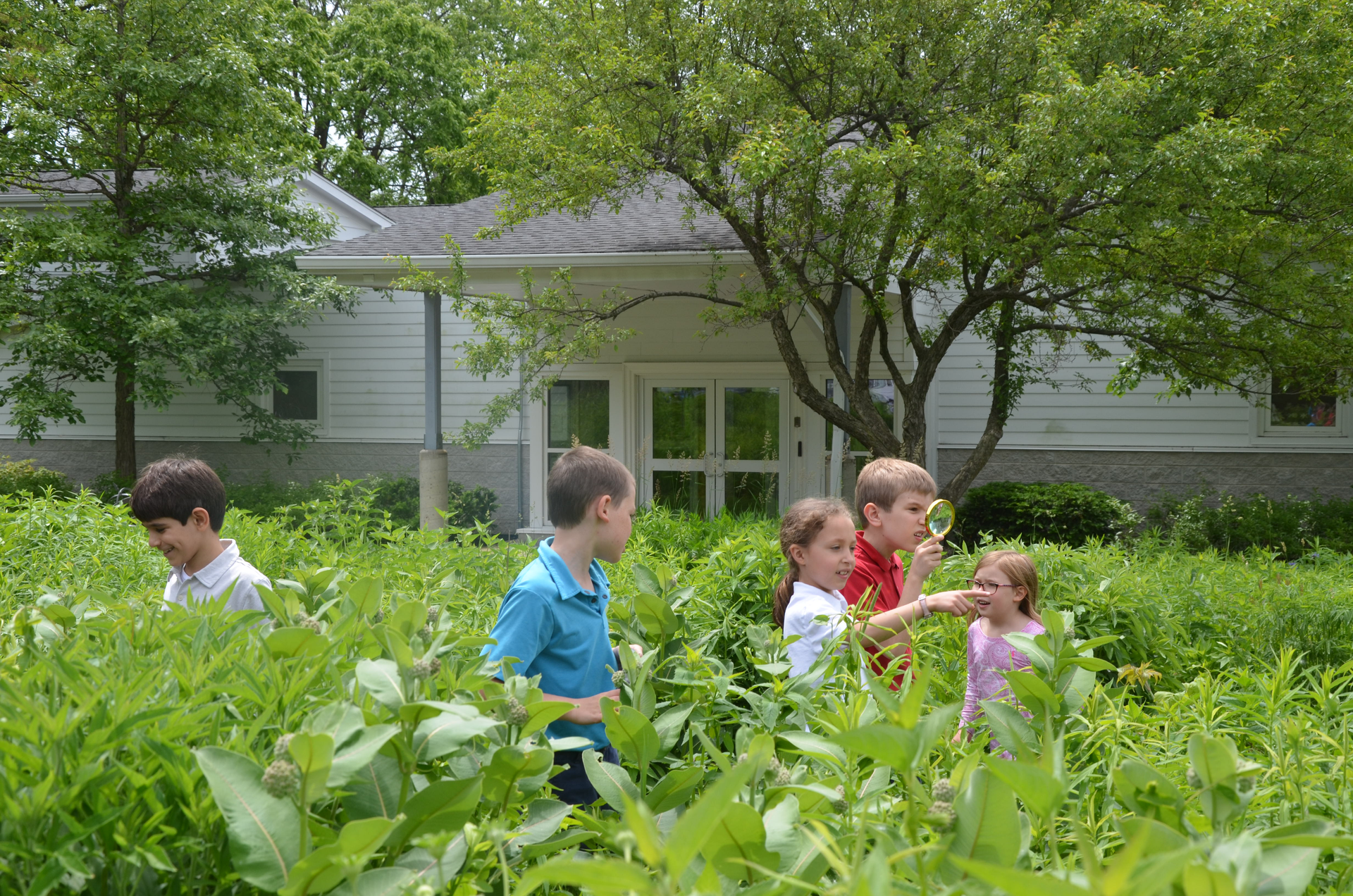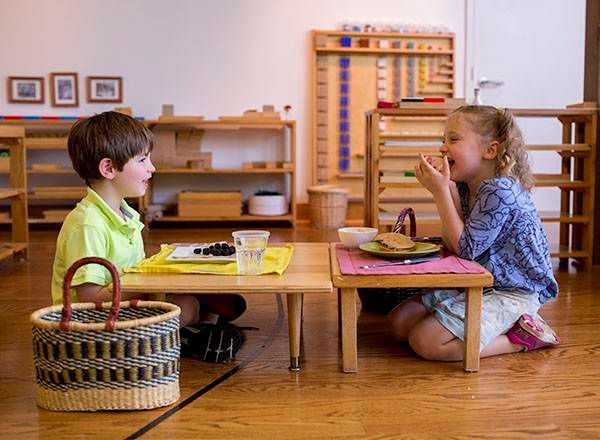
The body content of your post goes here. To edit this text, click on it and delete this default text and start typing your own or paste your own froThe Forest Bluff lunch is a quintessential Montessori experience that builds responsibility, self-esteem, cognition, and independence. Here we explain why this daily routine is so important, and we provide guidance to support families in this endeavor.
Forest Bluff School is known for not assigning homework. This is, in fact, a bragging right for alumni when they reach high school! Their peers are usually a little envious (and a little confused). Because so much work happens during the school day, there is no need for extra academic work at home. The time after school is meant for creativity, the outdoors, and family time.
However, Forest Bluff teachers will tell you that there are two important activities your child should be doing in lieu of homework: Reading and contributing to the home. While there are many productive ways your children can contribute to home life, one of the most important ones is preparing their own lunch. This is a daily routine that encourages and builds children’s responsibility and self-confidence. Children learn that they are capable of taking care of themselves, and that they can help with the running of the household!m a different source.
The Process of Independence
Your child will start staying all day at school the day they turn five. However, the ability to make one’s own lunch doesn’t happen overnight! The first step lies in the preparation they have had beforehand--the times that you have included them in Practical Life activities at home and asked them to participate in cleaning and care for the environment and themselves. School itself is also preparation for this work, as there is much that they do independently there.
Once your child is five, you can work towards giving them sole ownership of their lunch. Some children will be so ecstatic about the idea of staying all day with the “older children” that they may eagerly take on this task without much friction. However, this is not always a linear process. My own children were very enthusiastic about turning five, and they were thrilled to stay all day at school, but going from a three-hour school day to a seven-hour school day is a big jump! Some days they made their lunches quite independently, and some days they needed more support.
It also has been interesting to see how differently my children have responded to preparing lunch five days a week. One needed more guidance and discussion as they adapted to their new job, while one of them happily took on the role and probably would have cheerfully made their siblings’ lunches too!
We have found a process in our home for lunch that feels comfortable and balanced for all of us (most of the time). In the winter, our newly turned five-year-old was in charge of the dishes and linens in her basket. I usually prepared her food, but I did not take special requests! (Unless they were very simple). If she wants exactly what she wants, then she can choose to do it herself, and she often does.
After about a month, she adapted to her new schedule. At that time, she took responsibility for her fruit, vegetable, and dessert (a small cookie). I continued to provide her protein and carbohydrate. We will keep up this arrangement for a while, and at some time before her sixth birthday, she will take over the rest of her lunch, with continued guidance and support from me. She will have many periods of time before she is six when she will make her entire lunch on her own, and I will encourage this. However, for our family, this will not be a consistent expectation until she is six. Five-year-olds are very capable, but their stamina is still unpredictable! As I said, one of my children did not need much help from the very beginning, while the other appreciated the support.
By the time my daughter is in the elementary class at six and a half years old, she will have ownership of the entire process, and I will check in only occasionally. At this time, it can be helpful to have a list of the main categories that are available in your refrigerator each week. While my children know fruits and vegetables, “protein” can be a bit abstract for them, and it helps when we write “cheese, sliced turkey, hard-boiled eggs,” or whatever happens to be in the fridge at that time. I do not lean over their shoulders every time they make their lunches. If I notice they are regularly not making a well-rounded lunch, then we have a talk about it. I also once received a phone call from a teacher suggesting that our son may want to bring more than dates and celery for his lunch. I am always grateful when teachers bring patterns like this to my attention! This led to a good discussion about the importance of protein and fat.
Lunch Materials
From age five through the lower elementary, children bring their lunches in a basket. I have found that the elliptical baskets sold at The Mustard Seed in Lake Forest, IL, are the best size and general durability. We use duct tape to patch up holes as they develop, and we usually end up replacing the baskets about once a year. Once they are in the upper elementary, the children bring backpacks. We have liked the backpacks with a divided larger compartment because it allows for more organization.
Our children use linens and dishes that would not break my heart if they were ruined or broken. While it is important that the children are trusted with real glass and attractive linens, I do not want them to sense an emotional attachment on my part to any of their lunch materials. I remember weeping as a child when I broke a beautiful china plate I had brought to school that I thought my mother loved. I do not even remember her reacting when I brought home the broken pieces, so I know my assumptions were all in my head! However, the experience has reminded me to make sure my own children know I am not emotionally attached to any of their school dishes.
Our family uses bento boxes in an insulated lunch box with a freezer pack to carry food to and from school. The boxes have one larger compartment and two smaller compartments. For my children, this has helped them see the variety they need to bring for their own nutrition. One compartment for fruit, one for vegetables, and one for the protein and a possible carbohydrate. They also each have a lunch box for the bento to go in with a freezer pack that gets zipped in. They each have two packs, so that they have the flexibility of always having one in the freezer for the days they decide to do the entire lunch process in the morning.
(Note: During COVID, children bring water to school in a water bottle, and it is especially important that every item in their baskets are replaced or cleaned before coming back to school the following day.)
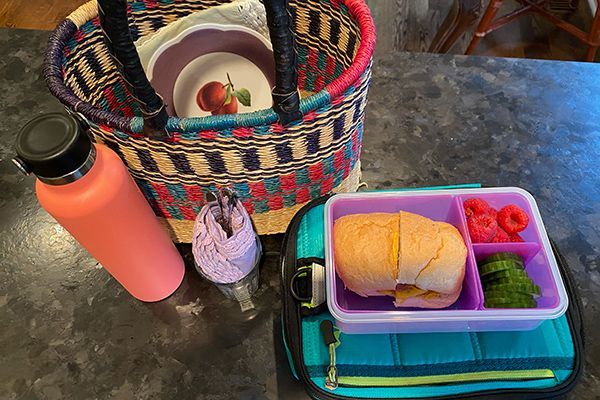
When Should They Make Their Lunches?
The answer to this question will vary for every family! For some children, they may find that emptying their basket right when they get home is a good habit. Then, after having a snack, they are ready to prep their basket items and to make and store their lunch for the following day. This allows children to enjoy the rest of their afternoon and evening without the rush of preparing their meal in the mornings.
When we first started making lunch for Forest Bluff School, I advised my children to follow this schedule, because I knew it had worked for many of the students in my own class when I was a teacher. However, I found that this was sometimes met with resistance! Especially for my newly turned five-year-olds (or when a child has transitioned to an older classroom), when they got home, they needed to unwind first. Children are different from each other, and it is important to observe and experiment to figure out what works best in your own home.
In the spirit of autonomy and collaboration, I decided to ask my own children when they liked making their lunches. “After dinner, when we are in pajamas, and it is peaceful in the kitchen,” was their first answer. “When I’m really tired, I like to do it in the morning because I have more energy,” was their second answer.
Children often know themselves better than we think they do! Likewise, children like to have reasonable choices about the responsibilities in their lives. We had a discussion and came to an agreement. As long as their lunches were always ready 10 minutes before we had to leave the house, they could make them whenever they wanted. This included me letting go of insisting that they clean out their baskets when they get home. It turns out that they do it quickly and efficiently when they are ready to do the work.
So far, they have always had their lunches ready by the deadline. However, they understand that on the day that they do not, we will revert to my schedule for the week, and they can earn back flexibility as they show their conscientiousness.
Forgetting the Lunch
If your child is in the primary class and they forget their lunch, you can bring it to them. They are not old enough to be fully responsible for always remembering it. If this becomes a regular occurrence however, talk to your child’s teacher about why this might be happening and revisit the process to help set them up for success.
If your child is in the elementary class, unless there are extenuating circumstances, the teachers ask that you do not rescue them. Rest assured, they will not go hungry! When an elementary child forgets their lunch, they go to the primary class to borrow what is needed. They put together a lunch from the leftover refreshments, such as cheese and crackers or an apple. For most children, the mild hassle of this process is enough to help them remember their lunch in the future. But if this happens repeatedly, speak to your child’s teacher about what your child may need to do to improve their lunch making routine and to remember to bring it to school. (During COVID, children will not borrow dishes and food from the primary. During this time, please call the school office if your child forgets their lunch to determine how to best handle forgotten items.)
Exceptions to the Routine
About once a week, one of my children has been tired enough that I can see that making their lunch is going to be a struggle for them. Usually they have been working especially hard at school, but sometimes it is because we just had our first sunny day in weeks, so they played outside for hours and now they are exhausted! The reasons vary, but in these cases, I help them make their lunches. They are aware that I am helping them and say thank you (which I will remind them to do if they forget!). While it is important that they feel it is their responsibility to make their own lunches, and it is good to experience doing things even when they are tired, it also is an appreciated kindness when someone steps in for support.
If I find that they are in this state repeatedly, we take a step back to figure out why they do not have enough energy for this important responsibility. Sometimes they need an earlier bedtime, and sometimes it means we have been too active after school and need a calmer routine.
Final Thoughts
The Forest Bluff lunch is a quintessential Montessori experience for our children. It is an element of self-care to work towards doing independently. It involves an understanding of processes, memory development, natural consequences, and information about health and nutrition. It builds true self-esteem and cognition.
Lunch is also a unique experience at school. At Forest Bluff, the teachers eat with children in small groups. They make and bring their own lunch, and converse freely. Some of my favorite memories as a teacher were those times I spent in natural conversation with the students I loved so much, enjoying the lunches we had all brought to school that day. We all came to the table with the peaceful sense of accomplishment that only comes when you have ownership of your own life, and the joyful feeling that you are truly capable.
(Note: During COVID, children will eat their lunches socially distanced outside, or peacefully on their own, in reflection or while reading a book they brought from home. Again, this is a moment when they can enjoy the feeling of ownership and competence!)
